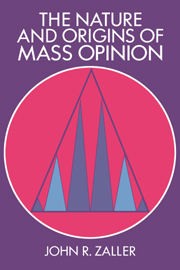Book contents
- Frontmatter
- Contents
- List of tables and figures
- Preface
- 1 Introduction: The fragmented state of opinion research
- 2 Information, predispositions, and opinion
- 3 How citizens acquire information and convert it into public opinion
- 4 Coming to terms with response instability
- 5 Making it up as you go along
- 6 The mainstream and polarization effects
- 7 Basic processes of “attitude change”
- 8 Tests of the one-message model
- 9 Two-sided information flows
- 10 Information flow and electoral choice
- 11 Evaluating the model and looking toward future research
- 12 Epilogue: The question of elite domination of public opinion
- Measures appendix
- References
- Index
11 - Evaluating the model and looking toward future research
Published online by Cambridge University Press: 05 June 2012
- Frontmatter
- Contents
- List of tables and figures
- Preface
- 1 Introduction: The fragmented state of opinion research
- 2 Information, predispositions, and opinion
- 3 How citizens acquire information and convert it into public opinion
- 4 Coming to terms with response instability
- 5 Making it up as you go along
- 6 The mainstream and polarization effects
- 7 Basic processes of “attitude change”
- 8 Tests of the one-message model
- 9 Two-sided information flows
- 10 Information flow and electoral choice
- 11 Evaluating the model and looking toward future research
- 12 Epilogue: The question of elite domination of public opinion
- Measures appendix
- References
- Index
Summary
“If the public had an opinion and there was no pollster around to measure it, would public opinion exist?” Like the old conundrum about the tree falling in the forest with no one to hear it, this question is not completely vacuous. The answer depends on what one means by public opinion. If by public opinion one means the hopes, fears, feelings, and reactions to events of ordinary citizens as they go about their private lives, then certainly there is public opinion whether or not there is a pollster to measure it. But if by public opinion one means ordinary citizens walking around saying to themselves things like “I strongly approve of the way George Bush is doing his job as president” or “I think we should take a stronger stand, even if it means invading North Vietnam,” then most of what gets measured as public opinion does not exist except in the presence of a pollster.
The RAS model has been about both kinds of public opinion, the “considerations” that people form in response to the flow of political communications, and the process by which they translate typically disorganized considerations into the survey responses that virtually everyone now takes as constituting public opinion.
To the extent one evaluates the RAS model on the conventional criteria of empirical breadth and theoretical parsimony, it looks quite good.
- Type
- Chapter
- Information
- The Nature and Origins of Mass Opinion , pp. 265 - 309Publisher: Cambridge University PressPrint publication year: 1992



